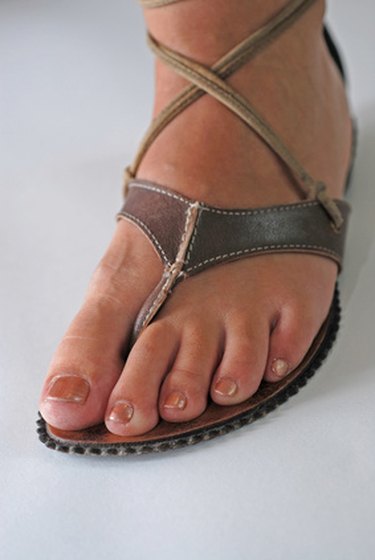In the world of special effects, silicone body parts are often used when the use of real body parts is impractical or unsafe. These body parts could be substituted for real body parts on an actor, used as severed limbs in a horror film or combined into an entire silicone body for a medical show. Many of these materials are expensive, but the resulting body part is hyper-realistic, will last years and is well worth the cost.

Video of the Day
Things You'll Need
Hot Glue Gun And Glue Sticks
Mixing Sticks
Petroleum Jelly
Silicone Pigment
Liquid Silicone Compound
Mixing Bowl
Board
Flexible Plastic Sheet
Vacuum Degasser (Optional)
Duct Tape
Alginate
Paper Mixing Bucket
Molding the Body Part
Step 1
Roll the plastic sheet into a tube large enough to fit the body part (in this case an arm) with at least 2 inches clearance all the way around.
Video of the Day
Step 2
Apply duct tape along the seam of the tube to seal it.
Step 3
Set one end of the tube on the board and glue it in place with hot glue. Be sure there are no leaks.
Step 4
Cover the arm to be molded in a thin coat of petroleum jelly as a release agent.
Step 5
Put the alginate powder (the same stuff the dentist uses to make a cast of your teeth) in the mixing bowl. The amount needed will vary depending on the body part you're making, but it's better to use too much than not enough.
Step 6
Add water to the alginate. Some brands have specific ratios of powder to water or you can slowly add water and mix until the alginate has reached a creamy consistency.
Step 7
Smear some of the alginate on the model's arm to capture the fine detail.
Step 8
Have your model hold his arm in the center of the tube.
Step 9
Pour the rest of the alginate into the tube around the arm. Tap the sides of the tube to dislodge any trapped air bubbles.
Step 10
Allow the alginate to set. This usually takes less than 10 minutes.
Step 11
Have the model carefully wiggle his arm free from the alginate mold. This should be done slowly to avoid ripping the mold.
Creating the Body Part
Step 1
Estimate the amount of silicone you think you will need. Again, this will vary depending on the body part you are making. Silicone sticks to itself, so you can always add more if you underestimate.
Step 2
Pour the amount of part A and part B into separate mixing buckets.
Step 3
Add flesh-colored pigment to part B and mix thoroughly. Use a few drops at a time. You can always add more, but you can't take any away if you use too much.
Step 4
Combine parts A and B in one of the paper buckets.
Step 5
Mix the silicone thoroughly. There should be no color striations if it has been mixed properly.
Step 6
Vacuum degass the silicone if you have the equipment. This will help to eliminate bubbles from the final product.
Step 7
Pour the silicone into the mold. If you pour it from high up and allow it to dribble into the mold, trapped air bubbles will break on the way down.
Step 8
Allow the silicone to cure. This could take anywhere from 30 minutes to 24 hours depending on the type of silicone being used.
Step 9
Remove the plastic sheet and tear the alginate mold away from the silicone body part.
Tip
To use less silicone (and less money), slush a skin of fast-curing silicone into the mold. Then fill the rest of the space with expanding foam.
Warning
Alginate shrinks as it dries. Once the mold is made, do not wait a long period of time before making the body part or it could come out distorted.